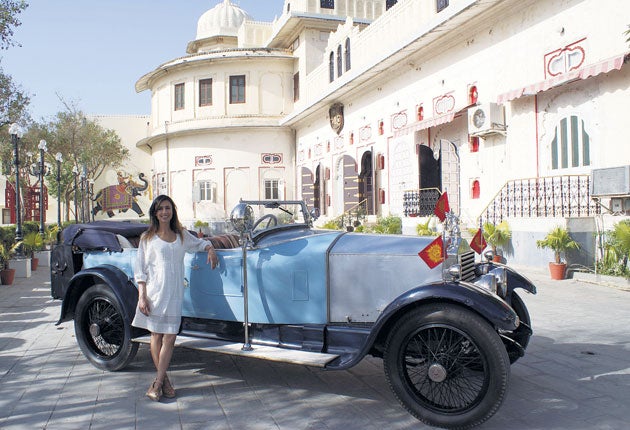Mary Dejevsky: When small laws are ignored
Notebook


Your support helps us to tell the story
From reproductive rights to climate change to Big Tech, The Independent is on the ground when the story is developing. Whether it's investigating the financials of Elon Musk's pro-Trump PAC or producing our latest documentary, 'The A Word', which shines a light on the American women fighting for reproductive rights, we know how important it is to parse out the facts from the messaging.
At such a critical moment in US history, we need reporters on the ground. Your donation allows us to keep sending journalists to speak to both sides of the story.
The Independent is trusted by Americans across the entire political spectrum. And unlike many other quality news outlets, we choose not to lock Americans out of our reporting and analysis with paywalls. We believe quality journalism should be available to everyone, paid for by those who can afford it.
Your support makes all the difference.Honestly, I'm no Cassandra, prophesying the end of the world, just because some areas of some English cities experienced some rioting a month ago. Nor have I added my voice to those blaming it all on declining standards of civic responsibility – either at the top of the scale with bankers and MPs, or at the bottom, with the teenage rioters and looters. It seemed to me that what happened reflected a combination of youth discontent, weak policing, opportunity, the lack of other things to do, and clement weather.
But I also have to say that my refusal to entertain the theory of civic irresponsibility was sorely challenged when I took the 436 bus recently almost the length of its route from south-east to north-west London. It so happened that my journey came a couple of days after the Mayor, Boris Johnson, launched a consultation about increasing the fines for fare-dodging, after learning that evasion, as it is delicately called, had reached a three-year high in 2010. The so-called bendy buses – such as the 436 – which you can enter without passing the driver are seen as particularly vulnerable.
Now the 436 runs through several of the areas worst affected by rioting, and I had a convenient observation perch close to the rear door. This was a crowded bus, with people getting on and off at every stop. My micro-survey showed that of all the males under, say 35, only two – of several dozen – actually touched their Oyster card on the reader. The proportion for older men was higher, and for females of all ages higher still – but still only around 50 per cent.
Of course, it's possible that those who did not touch their card on the reader had valid season tickets of some kind and I'm maligning the young men of London. But I somehow doubt that all were so equipped. I would also note that, as a regular bus-user, I have never encountered an inspector on a bendy-bus. I have also seen many drivers turn a blind eye to invalid cards if the would-be passenger looks a bit threatening. You can't blame them; the driver has no back-up if things turn nasty.
At the same time, it's hard not to believe that young bus travellers soon learn that they have a more than reasonable chance of getting away with neither a ticket nor a fine, and that only "suckers" actually pay. I rather think Transport for London could run the 436 – and perhaps other lines – as a free service without making too great a hole in its budget.
And I find it quite hard not to align myself with the zero-tolerance brigade here. Disregarding small misdemeanours, such as fare-dodging, surely encourages the idea that bigger ones – up to rioting and looting – will be treated with impunity. When I went to report on a post-riot session of a magistrates' court, all the accused already had a criminal record, so I was not surprised when the Justice Secretary, Ken Clarke, disclosed that four out of five rioters charged already had at least one conviction. Deterrence has not been working – and perhaps it starts with those unpaid fares.
Not quite Monte Carlo, but getting there
With India's population now above 1.2 billion and its growth rate still at almost 8 per cent, is it not time to abandon the images of the Raj that dominate so much of British coverage of India? A programme that did just this and exposed some of the fresh contradictions thrown up by new wealth and old poverty was the two-part documentary, India on Four Wheels, shown recently on BBC2.
Not only was this an appealing idea – what with Indian car ownership rising exponentially and India not obviously road-trip material – but with co-presenter Anita Rani it exploited the local knowledge and sense of dual identity that British Indians, as she described herself, inevitably feel. Road trips, such as the Tour de France and that hoary old chestnut, US Route 66 – which is to be given a new televisual airing shortly – supply tantalising tourism by proxy, changing landscape and snatches of ordinary life.
But India on Four Wheels offered an added novelty: the girl got the flashier car. While Justin Rowlatt loped along in a Hindustan Ambassador that had to be coaxed and cosseted into finishing the course, Anita travelled in style at the wheel of her state of the art 4x4 Mahindra. Better still, she not only looked as though she was enjoying herself, but as though she knew what she was doing as well.
A season of unusual fruitfulness
Miraculously, we survived the summer with only the barest murmur from growers about all the strawberries that would rot in their polytunnels because there was no one to pick them – this annual cry being the farmers' coded appeal to the Government to open the national borders to anyone prepared to pick fruit in return for the minimum wage, minus lodging costs. Of course, the silence was too good to last.
Friends and family with gardens and fruit trees confirm that this is a season of unusually mellow fruitfulness. So now we have a plum glut in Kent and orchard owners spreading gloom about how they can't afford to pick all the fruit, how it will rot on the branches and how the supermarkets are driving down wholesale prices to the point where the economics of plum-growing make no sense.
But what is this? In Lewisham last week, there were market stalls selling plums at 50p a kilo, and very good they were, too. Lugging my kilo home westwards, though, I couldn't but reflect that if the growers, or their go-betweens, drove their vans just a few more miles into the capital, they could double that price and those of us stuck paying £2 for a paltry punnet of "ripen in the bowl" plums at the supermarket would be mobbing their stalls for real plums at a real price.
Join our commenting forum
Join thought-provoking conversations, follow other Independent readers and see their replies
Comments